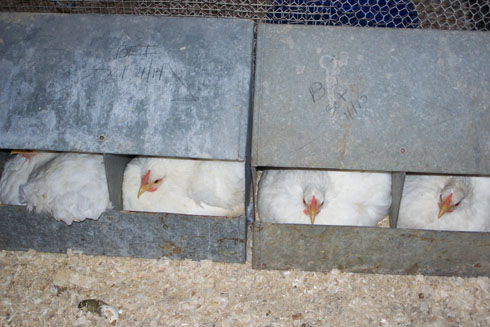 |

|
Currently there are no events or updates to display. |

Natural Incubation Some eggs, especially those of well bred lines of bantam ducks, tend to be difficult to hatch. One way to secure good hatches consistently from such eggs is to use natural incubation methods. Natural incubation uses a broody female instead of an incubator to incubate the eggs. The broody can be the female duck which layed the eggs, another female duck or a female chicken. Natural incubation can achieve excellent results but it usually requires some planning and some care during the incubation process. The location in which the broody incubates the eggs must be secure from predators and vermin and isolated from disturbances caused by other members of it's own flock. She must also have a place to exercise and have access to clean water and food whenever she needs it. In addition, the broody must be clean of parasites to begin with and must be kept that way during the 28 day incubation period. That means no lice or mites to torment the broody and then infest the ducklings. Broodies are prime targets for such pests because they are relatively immobile. The broody should be sprayed or dusted with an insecticide made for the purpose before she starts to sit and should be checked for parasites again on a weekly basis. The legs of chickens should also be watched for any sign of scaly leg mites, which can be killed with oil or kerosene. Remember, a chicken asked to incubate waterfowl eggs must set for a full week longer than would be necessary for her own eggs. She needs an extra measure of care, as a result.
These four Wyandotte bantam broodies have their own pen and there are no extra nest boxes in the pen to minimize the likelihood that a broody might return to an empty nest instead of her own. The date on which the eggs were set and the type of egg is recorded on the top of each nest.
Some broodies have better habits while incubating eggs than others. For example, some females will foul the nest with their droppings periodically which greatly increases the likelihood of bacterial contamination. Some are such "tight setters" that their caretaker must remove them at least once or twice each day from the nest to see that they exercise, eat, and drink. All broodies should be banded and records should be kept to insure that broodies which have good habits and are reliable are retained. Many females actually improve as broodies with age. Perhaps the biggest problem with natural incubation is having a broody ready to go when one needs one. By ready to go, I mean a broody which is in the mood to set and has done so for a minimum of 48 hours. Often, semi darkness tends to stimulate a duck or chicken to go broody a little faster. The easiest way to go is to allow the duck herself collect eggs in a good, secure nest until she decides to begin the incubation process. Do not allow her to set on more eggs than she can cover completely. If she attempts to hatch more than she can properly cover, she will chill each egg as she rotates them underneath her. The result may well be a poor hatch or no hatch at all. Know when the incubation begins and be around when the hatch starts to come off (usually on day 27). An alternative is to remove the eggs a couple of days before they are due to hatch and finish the process in an incubator. Have a brooder prepared and remove the ducklings as soon as they are dry and place them in the brooder. Yes, the mother can save you some trouble if she broods them herself but trust me, many ducklings are lost when left with the parent, especially when other birds are allowed to be around. Because of their very small size, bantam ducklings tend to be delicate at least at first and are generally best raised in a brooder.
The Nest
The Broody Most of the things said here can be applied to large ducks and geese. Muscovys usually make excellent setters and Runners probably the poorest. In the geese, Chinas as a rule are not reliable setters but Pilgrims are often very trustworthy, as are Egyptians. It may be necessary to add moisture periodically to waterfowl eggs in low humidity situations. Do so by sprinkling warm water on the eggs every other day or so once it is determined that the air cell is expanding too quickly. At hatch time, the air cell should be about 30% of the egg but not much more. One can mist the eggs to slow moisture loss but one cannot add moisture to eggs which have already lost too much. It is not necessary to mist chicken eggs. As in most things, good planning and attention to details will usually result in a successful outcome. Some trial and error will also be necessary especially when it comes to selection of individual birds as broodies. Do not trust an untried broody with valuable eggs if one can help it. Originally published: 01-10-2003 Last updated: 08-02-2010 |
Copyright © 1997 - 2025 Acorn Hollow Bantams. All Rights Reserved. | Terms of Use | Privacy Policy


